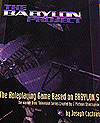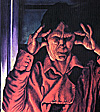 Licensed product start with advantages: people know the background, they can visualize peole andplaces easily, and there's a wealth of ancillary material around. Also, licensed products are a great way to get new players into the hobby.
Licensed product start with advantages: people know the background, they can visualize peole andplaces easily, and there's a wealth of ancillary material around. Also, licensed products are a great way to get new players into the hobby.
Judged in these terms, The Babylon Project is a bit of a disappointment. Experienced players won't be surprised to find out they can't play Sheridan, Ivanova, andthe rest, but newcomers to the hobby might. However, it geos a step further--it is set well before the pilot of the TV show. Babylon 5 does not exist. In fact, Babylon 4 is still under construction.
The other disappointment is presentation. Every page is full color, but the artwork ranges from mediocre to plain awful, and there are huge amounts of wasted space. There is a fair amount of background to get a campaign going. On the other hand, I see plenty of scope for add-on packs to follow.
One huge omission: no rules for space flight or space combat. They will follow shortly. With Jon Tuffley of Ground Zero Games writing them, they are possibly worth waiting for, but I didn't want to wait. How badly they are missed depends on the referee's games.
The game system is fairly simple and clean--no great innovations but a couple of good twists in the areas of character generation and combat.
 Character generation heavily relies on character development than points allocation or die rolling. With the exception of customizing a few attributes in the beginning, everything depends on a player thinking through their background. Only when complete are skills and characteristics given numerical values. Players and refs are urged to work together.
Character generation heavily relies on character development than points allocation or die rolling. With the exception of customizing a few attributes in the beginning, everything depends on a player thinking through their background. Only when complete are skills and characteristics given numerical values. Players and refs are urged to work together.
I do have one slight doubt on character generation. Skills and characteristics may be freely chosen, and there is nothing hardwired into the system to ensure play balance. It is eay for a greedy player or one into hack and slash to take advantage of this. With no guidance, new or gullible referees will find themselves in big trouble.
Moving onto mechnics of play, everything works on thesame basic system: add base attribute, skill, and specialization levels. Roll two dice (one positive and one negative), take the lower number and use that as a modifier. Compare with difficulty numbers set by referee, or with opposing roll from NPC, and check the degree of success. In play, it is remarkably swift, though remembering which die to use at first will take a moment or two.
the fun starts with armed combat. Each shot has a default target location, as shown on a hex-covered outline. This is the easiest place to hit. depending on the degree of success of tehshot, the player may hit this, near it, or miss altogether. The only trickly part is working out the location is the enemy is positioned differently than the outline. And the system allows one elegant little trick: want to work out cover? Cover the relavant parts of the outline with a piece of paper.
The other neat thing about the system is the way damage works out. Two phases: immediate and long term effects. Immediate work out while combat is in progress. Long term are slightly more complex, but are left until things quiet down. This may seem odd, but actually models the effect of an in-combat adrenaline rush quite neatly.
System could be lethal--it is easy to kill a person with one shot of a PPG. However, there is a "get-out" clause. Fortune points are awarded for good play--and used to modify die rolls--including reducing a fatal hit result to a critical injury.
 The final element in the book is a campaign outline. It has a lot of good things, especially on advice in developing a campaign that has an appropriate B5 story style. However, no scenarios are included. The campaign in the book expects players to play humans and humans are likely to be trusted by earthforce. This seems to be a great waste. My players were disappointed with that too.
The final element in the book is a campaign outline. It has a lot of good things, especially on advice in developing a campaign that has an appropriate B5 story style. However, no scenarios are included. The campaign in the book expects players to play humans and humans are likely to be trusted by earthforce. This seems to be a great waste. My players were disappointed with that too.
All in all, The Babylon Project has some great elements and does reflect the atmosphere of the show; but it is let down by poor artwork and a lack of thought given to the needs of beginning players. Experienced players--and especially refs who enjoy winging it and are willing to put in a bit of work into developing campaigns--will probably find it playable, flexible, and easy to learn.
More Reviews
-
Heavy Gear guides (roleplaying)
Deadlogue (miniatures and rules)
Vampire: Constantinople by Night (roleplaying)
Battle Cattle (miniatures rules)
Og: The Roleplaying Game
Castle Falkenstein: Book of Sigils (roleplaying)
Castle Falkenstein: Six-Guns and Sorcery (roleplaying)
Mage: Book of Worlds (roleplaying)
Deadlands (roleplaying)
Changeling: Shadow Court (roleplaying)
Earthdawn: Prelude to War (roleplaying)
Earthdawn Survival Guide (roleplaying)
Chivalry and Sorcery 3rd Edition (roleplaying)
Earthdawn: Arcane Mysteries of Barsaive (roleplaying)
Earthdawn: Throal Adventures (roleplaying)
In Nomine (roleplaying)
Babylon Project (roleplaying)
War Zone (seven miniatures rules)
Back to Valkyrie 14 Table of Contents
Back to Valkyrie List of Issues
Back to MagWeb Master Magazine List
© Copyright 1997 by Partizan Press.
This article appears in MagWeb (Magazine Web) on the Internet World Wide Web.
Other military history articles and gaming articles are available at http://www.magweb.com